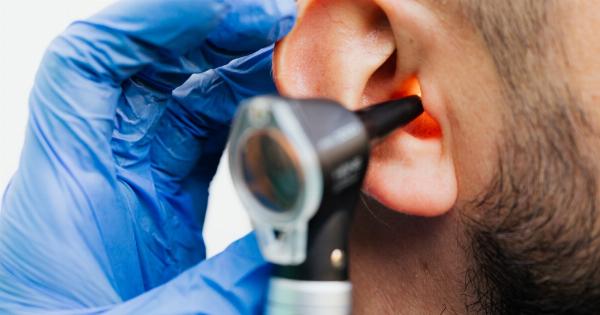Feeling a sensation of fullness in your ears can be quite uncomfortable and disruptive to your daily activities. It can affect your hearing, balance, and overall quality of life.
In this article, we will explore the various causes of ear fullness and the different treatment options available to alleviate this distressing condition.
Causes of Ear Fullness
There are several factors that can lead to the sensation of fullness in the ears. These include:.
1. Eustachian Tube Dysfunction
The Eustachian tubes are small passages that connect your middle ear to the back of your throat. Their primary function is to regulate air pressure and equalize it between the middle ear and the environment.
When these tubes become blocked or fail to open properly, it can result in ear fullness. Eustachian tube dysfunction is often caused by allergies, sinus infections, colds, or changes in altitude.
2. Excessive Earwax
Earwax, also known as cerumen, is a natural substance produced by the ear to protect and lubricate the ear canal. However, excessive accumulation of earwax can block the ear canal, leading to a sensation of fullness.
This can be exacerbated by improper ear cleaning techniques or the use of earplugs or hearing aids that push the wax deeper into the ear.
3. Fluid Accumulation
Fluid buildup in the middle ear, known as serous otitis media, can cause ear fullness and temporary hearing loss. This condition is commonly associated with upper respiratory infections, allergies, or a dysfunction of the Eustachian tubes.
The accumulated fluid prevents the proper movement of the eardrum and the tiny bones in the middle ear, leading to a feeling of fullness or pressure.
4. Middle Ear Infections
Middle ear infections, also called otitis media, occur when the middle ear becomes inflamed due to bacterial or viral infections. This can cause ear fullness, pain, and hearing loss.
Middle ear infections are more common in children but can also affect adults. Prompt medical attention and appropriate treatment are necessary to prevent complications.
5. Temporomandibular Joint (TMJ) Dysfunction
The temporomandibular joint connects the jawbone to the skull and allows for jaw movements. TMJ dysfunction can cause pain and discomfort in the jaw joint and surrounding muscles.
In some cases, it can also lead to referred ear symptoms, including ear fullness or a sensation of blocked ears.
6. Barotrauma
Barotrauma occurs when there is a sudden change in air pressure, such as during flying, scuba diving, or driving through mountainous areas. The rapid pressure changes can cause ear fullness, pain, and even damage to the eardrum or middle ear structures.
This condition is commonly known as “ear popping” or “ear barotrauma.”.
7. Meniere’s Disease
Meniere’s disease is a chronic disorder of the inner ear that affects balance and hearing.
It is characterized by episodes of vertigo, tinnitus (ringing in the ears), fluctuating hearing loss, and a feeling of fullness or pressure in the affected ear. The exact cause of Meniere’s disease is unknown, but it is believed to involve a combination of genetic and environmental factors.
8. Allergies
Allergies can cause inflammation and congestion in the nasal passages and Eustachian tubes, leading to ear fullness. This is commonly seen in individuals with hay fever or allergic rhinitis.
Identifying and managing the underlying allergies can help alleviate the symptoms and reduce ear fullness.
9. Tumors
In rare cases, tumors affecting the middle ear, temporal bone, or auditory nerve can cause ear fullness.
These tumors can be benign (non-cancerous) or malignant (cancerous) and require medical intervention or surgical removal, depending on the type and location.
10. Stress and Anxiety
Prolonged stress and anxiety can lead to muscular tension and changes in the body’s response to stress hormones. These physical changes can affect the ears and cause symptoms such as ear fullness or pressure.
Learning stress management techniques and seeking professional help can aid in reducing these symptoms.
Treatment Options for Ear Fullness
Treatment for ear fullness depends on the underlying cause. Here are some common treatment options:.
1. Eustachian Tube Exercises
If eustachian tube dysfunction is causing the ear fullness, performing specific exercises can help open the tubes and equalize pressure.
These exercises involve swallowing, yawning, or chewing gum to encourage the movement of the muscles that control the eustachian tubes.
2. Decongestants and Nasal Sprays
For ear fullness resulting from allergies or sinus congestion, decongestants and nasal sprays can provide relief by reducing nasal inflammation and opening up the Eustachian tubes.
However, prolonged use of nasal sprays should be avoided, as it can lead to dependency or rebound congestion.
3. Earwax Removal
If excessive earwax is the cause of ear fullness, it can be removed by a healthcare professional using specialized instruments or by using earwax softening drops.
It is important not to attempt removing earwax at home with cotton swabs or any other objects, as it can push the wax deeper into the ear canal or cause injury to the ear.
4. Antibiotics
If an ear infection is diagnosed, antibiotics may be prescribed to clear the infection and alleviate the symptoms. It is crucial to complete the full course of antibiotics as prescribed by your healthcare provider to ensure effective treatment.
5. Ear Pressure Equalization Devices
Specialized devices, such as ear pressure equalization (EPE) devices or earplugs with air vents can help equalize pressure during rapid altitude changes or while flying.
These devices allow for gradual equalization of pressure, reducing the risk of barotrauma and ear fullness.
6. TMJ Therapy
If TMJ dysfunction is causing ear fullness, treatment options may include pain medication, physical therapy, oral appliances, or bite adjustments.
A healthcare professional specializing in TMJ disorders can provide an accurate diagnosis and recommend appropriate treatment approaches.
7. Diuretics and Vestibular Suppressants
For individuals with Meniere’s disease, medications such as diuretics or vestibular suppressants may be prescribed to reduce fluid buildup and control symptoms.
Dietary modifications, stress management, and avoiding triggers like caffeine and salt are also important in managing the condition.
8. Allergy Management
If allergies are the cause of ear fullness, identifying and avoiding allergens, taking antihistamines, and undergoing allergy immunotherapy (allergy shots) can help alleviate symptoms and prevent future episodes.
9. Surgical Interventions
In cases where other treatments have been unsuccessful or when tumors are present, surgical interventions may be necessary. These can include procedures to drain fluid from the middle ear, repair structural abnormalities, or remove tumors.
It is essential to consult with an ENT specialist to determine the most suitable surgical approach.
10. Stress Reduction Techniques
For individuals whose ear fullness is associated with stress and anxiety, various stress reduction techniques can be beneficial. These include meditation, deep breathing exercises, yoga, regular exercise, and seeking therapy or counseling.
Conclusion
Ear fullness can significantly impact a person’s quality of life and should not be ignored. It is important to identify the underlying cause of this sensation to determine the appropriate treatment.
Consulting with a healthcare professional, preferably an otolaryngologist (ENT specialist), is crucial for accurate diagnosis and effective management of ear fullness. With the right treatment approach, it is possible to alleviate the discomfort and restore normal ear function.

























